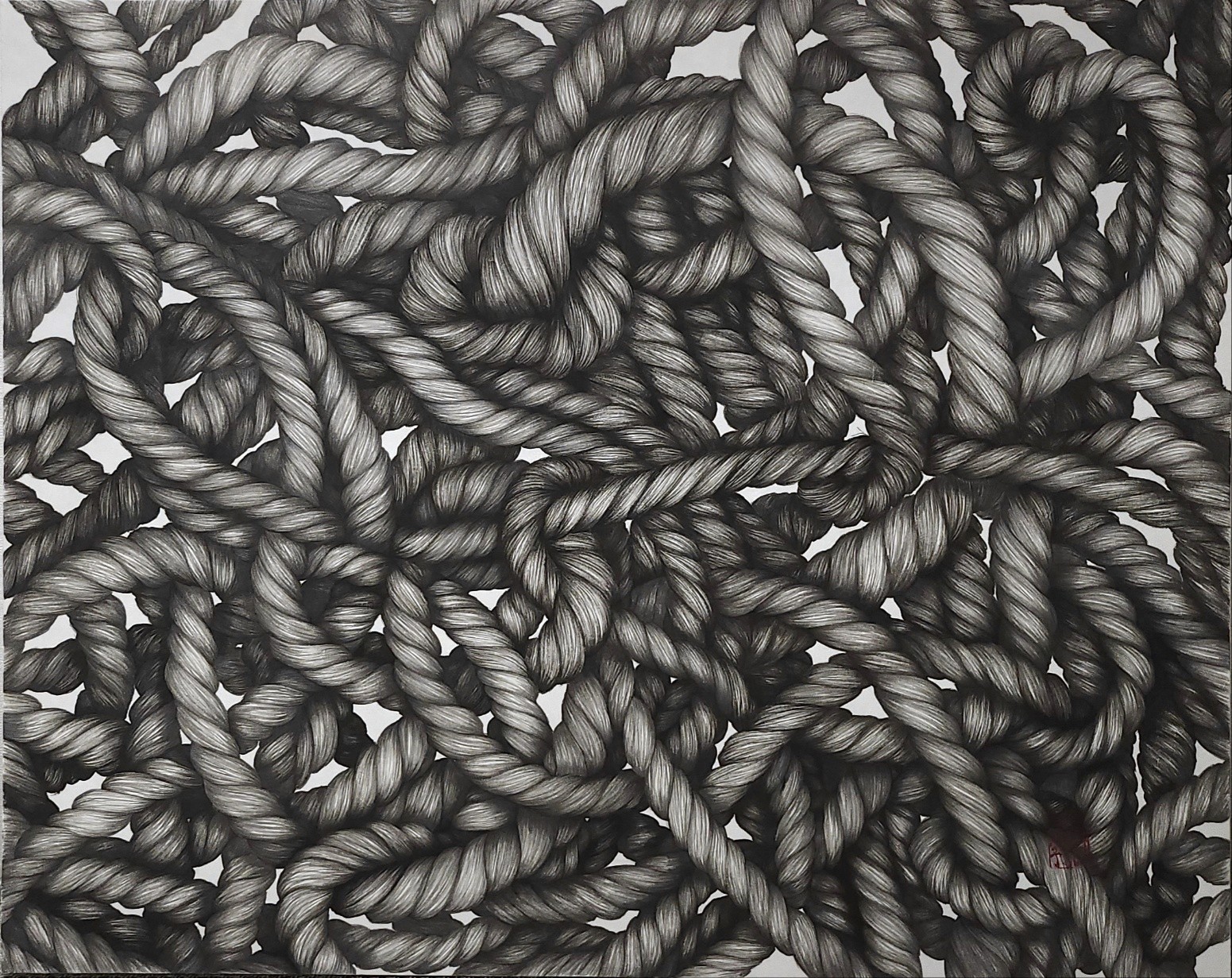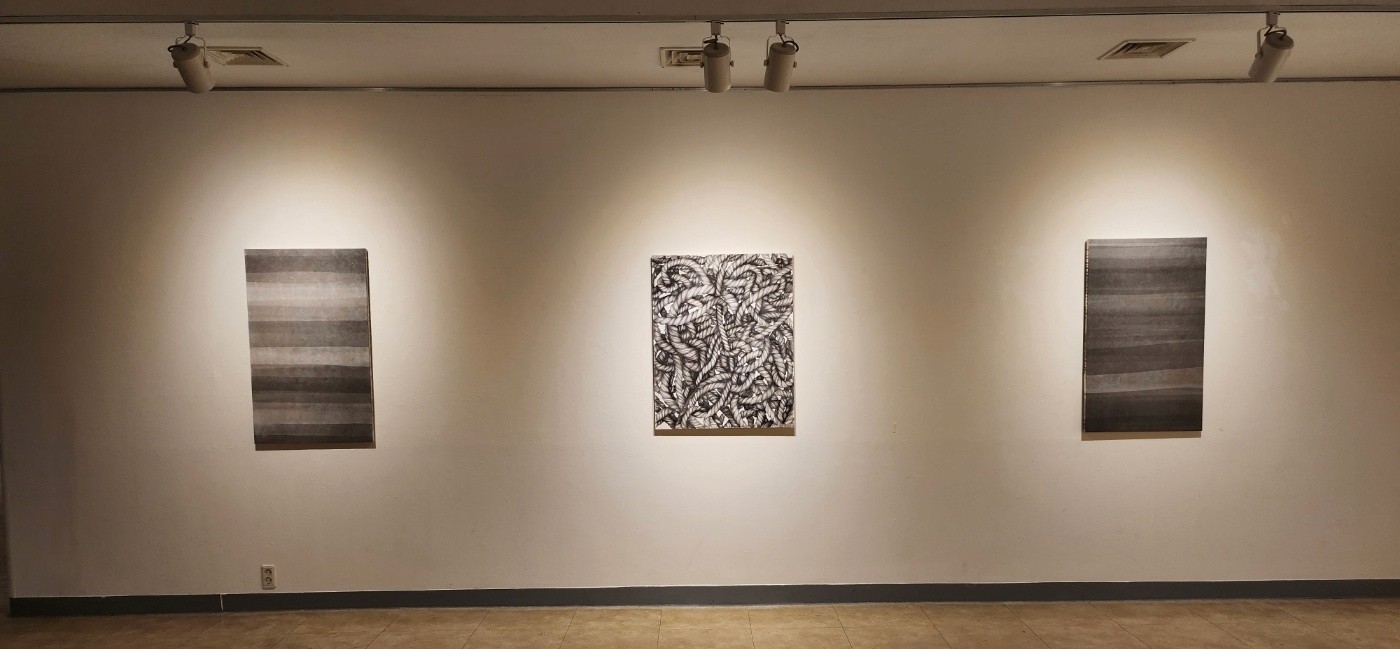
NFT
Creator
ND MAGAZINE
Date
Aug 28, 2024
1. What materials are commonly used in the works of artist Yeonseo Lee?
My work is rooted in traditional Korean painting, primarily utilizing Hanji (Korean paper) and ink. The unique texture of Hanji and the deep expressiveness of ink are essential elements in realizing the aesthetic world I explore. These materials do more than just adhere to tradition; they contribute to creating new artistic value with a contemporary sensibility.
2. What is the significance of 'lines' in the artist's work?
The line is the most fundamental and significant element in my work. It’s one of the most primal forms of expression in art, existing since humans first began to visually record their world. A line can represent a shape or appear as a seemingly meaningless mark, yet it’s the most essential expression that arises at the intersection of human consciousness and the subconscious.
In traditional Korean painting, a line carries more than just shape—it embodies a spiritual essence. When I paint, I hold the brush intuitively, and I place great importance on the natural formation of lines. These line drawings transcend simple forms, revealing my inner self and emotions, achieving artistic completeness in their own right. In Korean painting, lines are crucial tools for exploring the inner human world and the essence of nature, far beyond their role as mere visual language.

3. What is the most important element in the artist’s creative process?
Nature plays the most vital role in my creative process. Elements of nature like water, wind, and sunlight enhance the inherent qualities of each material and forge relationships between them. In Korean painting, everything begins and ends with the involvement of nature. Nature ties everything together and coexists within the artwork without leaving a trace. It is within this framework that I draw artistic inspiration and complete my work. The changes and flow of nature are crucial forces that breathe life into my creations.
4. What materials and techniques does the artist primarily use?
I mainly work with Hanji and ink. My techniques include ink wash painting and meticulous brushwork, which I use to add depth and detail to my pieces. The ink I use doesn’t merely signify black—it holds the potential to encompass the full spectrum of natural colors. While minimizing the use of color, I emphasize the essence and inner nature of my work through varying shades and the natural tones of ink. This approach reinterprets traditional Korean painting elements within a contemporary context, offering a profound aesthetic experience.
5. What was the theme of the artist’s recent solo exhibition 'Access to Space'?
My recent solo exhibition, titled "Access to Space," was held with the support of the city of Busan and the Busan Cultural Foundation. This exhibition featured works centered around lines, exploring space, time, and the human inner world. Lines, in this context, are more than just visual elements; they become tools that create new meanings within their relationship to space. The exhibition aimed to depict the expansion of space created by the meeting and crossing of lines and the unfolding inner world within.
Throughout the two-month exhibition, I presented my artistic explorations and experiments on this theme, hoping that viewers would perceive space in new ways through lines and discover their own emotions and interpretations within that space.

6. What is the meaning behind the artist’s work '千災雪消 萬福雲興(A thousand calamities disappear, a thousand blessings rise.)'?
The piece "千災雪消 萬福雲興" translates to "As a thousand calamities melt away like snow, ten thousand blessings rise like clouds." This work conveys a hopeful message that the hardships we perceive as disasters will eventually disappear, making way for even greater blessings.
By taking a long-term perspective on life, I express the positive view that the difficulties we face will fade with time, and greater happiness and opportunities will emerge. The flow of lines and shapes within the piece visually represents this process of change and renewal, conveying a message of overcoming and hope through the natural movement and contrast of lines.
7. What do the twisted line patterns in the 'Asceticism #1, #2' series symbolize?
The twisted lines in "Asceticism #1, #2" symbolize the complex relationships in life and the individual’s journey within them. Drawing one line after another, while they may appear similar from afar, reveals up close that every line is unique—just as each life is distinct and irreplaceable.
These lines intertwine, connect, sometimes break, and unravel, reflecting the Buddhist concept of '不一不異' (Not One, Not Two), which suggests that all relationships in this world are different yet interconnected. While "Asceticism #1" captures the dense complexity of these worldly entanglements, "Asceticism #2" focuses on the individual’s inner conflict and emotions. The space behind the ropes represents the weight of personal life, creating a sense of volume and gravity. Through this expression, I aim to show that even simple lines can be dynamic and three-dimensional, conveying rich emotions with traditional materials like Hanji and ink.
8. What visual effects and meanings are conveyed by the repetition of horizontal lines in the 'Emptying #1-#3' series?
In "Emptying #1-#3," the repetition of horizontal lines is an attempt to harmonize the material and spiritual qualities of ink. Rather than a descriptive approach, these works emphasize the subtle gradations and physical properties of ink, achieved through controlled force, aiming to express a state that is both humble and in harmony with nature.
Ink, in its essence, reveals a fundamental form that can express everything without mimicking the color of objects. The layered effect of repeated horizontal lines visually represents the flow of time and space, exploring the balance between the subconscious and consciousness. This multilayered repetition of horizontal lines moves beyond the artificial, maximizing the depth of Korean painting, and allowing a sense of weight and space even on a flat surface. Through these works, I focus on the materiality of ink, inviting viewers to appreciate its inherent qualities while feeling a sense of calm and tranquility in the depth and emptiness of the composition.
9. How is the contrast between 'emptiness' and 'fullness' expressed in the artist's work?
In my work, the contrast between 'emptiness' and 'fullness' embodies the cyclical nature of life and nature, playing a key role in exploring the relationship between the two within the canvas. A significant realization in this process is that all of this is possible only through the passage of time.
The repetitive act of drawing lines with ink occurs naturally in the subconscious, and after this act concludes, the immaterial and material are recreated in a continuous cycle over time. This symbolizes the harmony between the physical and spiritual realms, with the traces that emerge by chance gaining new meanings. In this process, I embrace the minimalist aesthetic that is a hallmark of Korean painting, minimizing every step to explore the essence of action and material. As a result, I experience 'emptiness' as a new form of 'fullness,' incorporating the vibrant spirit of traditional Korean art into my work. This contrast goes beyond mere visual expression, serving as a crucial element in visually conveying a deep reflection on existence and relationships.
10. What message do you wish to convey with your recent NFT artwork?
The recent NFT work, "32 Life," launched through ND and Rarible, continues the series that encapsulates a year of my life. This piece is a continuation of the "31 Life" series, recording each year of my life by visually expressing the emotions and experiences of that time. This time, I have incorporated AI technology to create a video, using traditional Korean ink to shape all the emotions I experienced over the year.
"32 Life" aims to share the flow of my life, the changes in my emotions, and the meanings embedded within them with the audience in the digital realm. Through this work, I explore how everyday and inner moments of life evolve with time and how this evolution can lead to new forms of artistic expression. Additionally, the work showcases how tradition and modernity, analog and digital, can blend together, offering a new kind of artistic experience that merges the deep emotions of Korean painting with the possibilities of contemporary technology. I hope this work gives viewers a chance to reflect on their own lives and re-interpret their emotions and experiences through art.

ND MAGAZINE
Sign in

